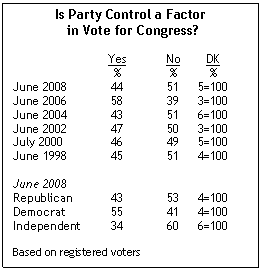Growing Democratic Party ID Advantage

The Democratic Party’s advantage in party identification among voters nationwide has continued to grow in the first half of 2008. Among all the registered voters interviewed by the Pew Research Center from January through June of this year, 37% identify themselves as Democrats, the highest annual average in 20 years. Meanwhile, just 28% say they are Republicans which, coupled with the 2007 average, is the lowest in more than 16 years. The nine-point Democratic advantage in party identification represents a substantial shift from the 2004 election cycle, when Democrats outnumbered Republicans by just two percentage points (35% to 33%).
The share of voters who identify as independents or offer no partisan preference is also greater this year than in most recent elections.

Currently, 35% do not identify with either of the political parties, up from 32% four years ago. The last time independent identification was this high was in 1992, when Ross Perot ran a fairly successful third party campaign.
More recently, however, the proportion of Americans who reject party labels has declined. In 2007, 37% of voters called themselves independent or expressed no partisan preference. This has fallen to 35% for the first six months of 2008, and the downward trend is even more apparent when the data is analyzed more closely. Over the past three months, just 34% of voters have identified as independents, down from 36% in the first three months of the year, and from 40% in the comparable second quarter of 2007.
Race for Congress

Asked whom they’d support for Congress in their districts, voters choose the Democratic candidate over the Republican candidate by a wide margin. More than half of voters (52%) say they would vote for the Democratic candidate, compared with 37% who would support the Republican.
Democrats hold substantial advantages among voters in several key groups, including women (22 points), those under age 30 (22 points) and Catholics (16 points). Independents, who are about evenly divided in their presidential preferences, favor the Democratic candidate in their district by 10 points.
Republican candidates hold about a two-to-one lead among white evangelical Protestants (59% to 28%), but most other groups are divided or favor Democratic candidates by wide margins. Democrats hold a slight edge among voters ages 65 and older (46% to 42%), and much wider advantages among voters in other age groups.
Voters are divided over whether the issue of which party controls Congress affects their vote for Congress: slightly more than half (51%) say no, while 44% say yes. This split has been fairly consistent since at least 1998, with the notable exception of the midterm election two years ago. In June 2006, 58% of voters, and fully 72% of Democrats, said the issue of party control of Congress was important to their vote.

Compared with two years ago, Democrats are much less likely to say that party control of Congress will be a factor in their vote. Still, more Democrats (55%) than Republicans (43%) or independents (34%) say that the
issue of which party controls Congress will matter in their voting decision.


